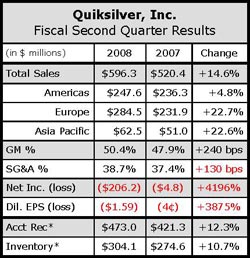Quiksilver, Inc. officially ran up the white flag on  its hardgoods business at the end of the fiscal second quarter as it separated the Rossignol business into discontinued operations, while taking a hefty charge on the bottom line. The company took a $240.2 million hit in anticipation of the planned sale. Without the charge, the company would have reported net income of approximately $38.7 million, up from $32.4 million last year.
its hardgoods business at the end of the fiscal second quarter as it separated the Rossignol business into discontinued operations, while taking a hefty charge on the bottom line. The company took a $240.2 million hit in anticipation of the planned sale. Without the charge, the company would have reported net income of approximately $38.7 million, up from $32.4 million last year.
Bob McKnight, president and CEO, said the companys “initial list of potential buyers has been reduced to a select group of candidates who have now received the confidential background data. We expect this process to proceed at a reasonable pace and to conclude with a competitively-priced sale of this business in its entirety ”
On a conference call with analysts, management said the Rossignol business performed according to plan, but did not elaborate further. They did say that typically, Rossignol would experience a loss in the $20 million to $30 million range for the quarter, and that the current quarterly loss was “of that magnitude.”
With approximately 50% of Quiksilvers owned-retail store count in California, Nevada, Arizona and Florida, it is no surprise that management estimated comps were down in the U.S. However, Europe was also down for the business, with management attributing that decrease to weather.
Apart from owned-retail, Marty Samuels, president Quiksilver Americas, commented that, “In the core market, I think they are also probably experiencing sales that are flat to minus 5, but it depends on the markets. I think the East Coast, Florida and Hawaii have had a little bit better weather, so they have done a little bit better with the seasonal products. On the West Coast here and I think in the Midwest it has been unseasonably cool, so I think for those retailers it is a little bit more challenging.”
The companys e-commerce business was said to be “very strong” with the implication that consumers are shopping online to avoid driving to a store to make purchases.
Despite the soft owned-retail and retail in general, Quik saw a strong performance from the DC shoes brand for the quarter. The Quiksilver brand itself was said to be slightly down with Roxy experiencing the same trend. Samuels said that “a huge pick up in orders” with other mall-based chains paired with “tremendous growth” in DC apparel would more than offset the business lost to PacSuns decision to severely cut back its footwear program.
On a regional basis, Europe provided the only real bright spot for ZQK in the quarter, though all regions saw gross margins improve as the company works to improve its sourcing. The international business also benefited from currency translation effects, which added approximately $44 million to net sales.
In the Americas, gross margin improved 130 basis points to 42.7% of net sales, but SG&A expenses grew 380 basis points to 36.2% of net sales, more than offsetting the GM improvement. As a result, operating income for the region fell 25.5% to $15.7 million from $21.1 million for the year-ago quarter.
In Europe, gross margin improved 290 basis points to 56.8% of net sales. SG&A expenses increased 110 basis points to 34.5%, but the GM expansion paired with the 22.7% jump in net sales to boost operating income by 33.1% to $63.7 million from $47.8 million last year.
The Asia Pacific region saw gross margin improve 290 basis points to 50.7% of net sales. That growth was offset by a 170 basis point increase in SG&A expenses to 51.5% of net sales, which caused the regions operating loss to widen to $477,000 from approximately $66,000 last year.
For the full year, revenues from continuing operations are expected to grow by 10% to approximately $2.25 billion from net sales of $2.05 billion last year. Earnings per share are expected to be “slightly below” the 90 cents reported last year.
Though the company does not give quarterly guidance, management did note that sales growth is expected to be stronger in the fourth quarter than in Q3 and that earnings per share for the third quarter “could be approximately 20% below that of last year.” In number terms, the company would be looking at Q3 earnings per share of 23 cents, down from 29 cents for the year-ago period.
The write-down looks tough on paper, but there has to be a breath of relief now that the Rossi debacle has nearly come to a close…














